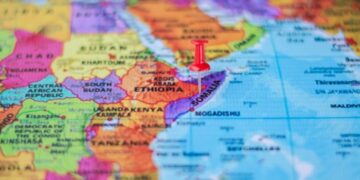The Norwegian Safety Investigation Authority (NSIA) issued its accident report on the loss of propulsion and near-grounding of cruise ship Viking Sky on 23 March 2019.
Summary
In the afternoon of 23 March 2019, the cruise vessel Viking Sky experienced a blackout, causing loss of propulsion and steering, during a storm in the Hustadvika area of the Norwegian coast. The vessel is estimated to have come within a ship’s length of running aground with 1,374 persons on
board, and the accident had the potential to develop into one of the worst disasters at sea in modern times.
The accident was caused by insufficient lubricating oil in all of the operating diesel generators’ lubricating oil sump tanks, in combination with pitching and rolling in rough seas. The investigation has identified operational, technical, and organisational safety issues that in different ways contributed to the blackout.
The blackout recovery was time consuming, and it took 39 minutes from the blackout until both propulsion motors were operational and the ship had sufficient power available to maintain between 1 to 5 knots ahead. Blackout drills had been carried out, but recovery from a full blackout without a standby generator had never been drilled on board. The engineers were therefore faced with a situation they were not practised in managing. The situation was stressful, the control
system was complex, and a specific sequence of actions was needed. Insufficient training likely contributed to why the blackout recovery was time consuming.
When Viking Sky left Tromsø 21 March 2019, with one out of four diesel generators unavailable, both crew and passengers were unknowingly exposed to an increased risk as the vessel did not have the redundancy required under the Safe Return to Port (SRtP) regulations. As Viking Sky did not comply with the applicable safety standards, it should not have departed Tromsø under the prevailing circumstances.
Main findings
Viking Sky suffered a blackout when all three operational diesel generators (DGs) were shut down by their protection systems responding to low lube oil pressures. The low lube oil pressure was due to low levels of lube oil in the sump tanks in combination with the vessel motion, causing the lube oil suction pipe opening to be exposed to air. The vessel encountered strong winds and heavy seas, as forecast, but the vessel motion at the time of the first engine shutdown was significantly below the design criteria.
Since the departure from Tromsø two days before, no oil had been transferred into the DG sump tanks even though low lube oil level alarms went off both for DG2 and DG4 during the voyage, and the heavy weather checklist, that included an item requesting the lube oil sump tank levels to be optimised, was logged as completed. None of the vessels in the fleet of five sister vessels had been provided with instructions on correct lube oil sump tank filling levels or alarm setpoints. In June 2016, the engineers working on board the sister vessel Viking Sea requested information from MAN regarding the recommended oil levels. MAN was unable to give a clear answer as the tanks were designed by the shipyard and not by them. The shore organisation of the ship management company was made aware of the email exchange between Viking Sea and MAN. However, no guidance on correct filling levels or alarm set points was issued by the ship management company until after the accident on Viking Sky.
About the investigation
Purpose and method
The NSIA has classified this accident as a very serious marine casualty. The purpose of this investigation has been to clarify the circumstances of the accident and identify safety issues and contributing factors. The NSIA has also considered what can be done to improve safety and prevent the recurrence of similar accidents and consequences in the future. The investigation was conducted in line with the NSIA’s framework and analysis process for systematic safety investigations (the NSIA method).
Organisation of the investigation
The safety investigation into this accident was conducted in accordance with the Norwegian Maritime Code, chapter 18 II implementing IMO Resolution MSC.255(84) Casualty Investigation Code (CIC) and Directive 2009/18/EC of the European Parliament and of the council of 23 April 2009. The Norwegian Safety Investigation Authority (NSIA) has been the lead investigating authority. The United Kingdom (UK), the United States of America (USA), Australia and Italy were considered Substantially Interested States (SIS) in accordance with the Norwegian Maritime Code section 474. The United Kingdom’s Marine Accident Investigation Branch (MAIB), the United States Coast Guard (USCG) and the United States’ National Transportation Safety Board (NTSB) worked with the NSIA, as representatives of the SIS. In addition to the MAIB, NTSB and USCG, the Australian Transport Safety Bureau (ATSB) assisted in collecting evidence for the investigation.
The investigating authorities worked closely with Wilhelmsen Ship Management, Viking Ocean Cruises, Fincantieri S.p.A., MAN Energy Solutions (MAN), Wärtsilä, Lloyd’s Register (LR), the Norwegian Maritime Authority (NMA), the Norwegian Costal Administration (NCA) and other interested parties.
On 12 November 2019 an interim report on the accident was published by the Norwegian Safety Investigation Authority, with contributions from the MAIB, the NTSB and the USCG.
Sources of information
The facts are based on interviews with the vessel’s crew and passengers, examination of technical shipboard systems, VDR, CCTV, the JRCC’s operations log, the Norwegian Coastal Administration’s AIS log, information obtained from the Norwegian Maritime Authority, the owner, the shipping company, the shipyard, equipment makers, the classification society, the Norwegian Meteorological Institute, and other sources.
The investigation report
The first section of the report, Factual information, describes the sequence of events, associated data and information gathered in connection with the accident, and the NSIA’s examinations and related findings. The second section, Analysis, describes the NSIA’s assessments and analyses of the sequence of events and contributing factors, on the basis of factual information and examinations carried out.
Safety recommendations
The Norwegian Safety Investigation Authority proposes the following safety recommendations for the purpose of improving safety at sea:
Safety Recommendation Marine No. 2024/06T
On 23 March 2019 Viking Sky was less than a ship length from running aground during a storm in Hustadvika, Norway. With more than 1,300 persons on board, the cruise ship suffered a blackout due to loss of lubricating oil pressure caused by insufficient lube oil in the engines’ sump tanks. The investigation has shown that the lube oil sump tank design did not comply with SOLAS II-1, Part C, Regulation 26.6 and LR Class Rules Part 5, Chapter 1, Section 3.7 on safe operation under dynamic inclination nor with the recommendations of the engine manufacturer. The sump tank design is critical to safe engine operation, yet the shipyard’s design process did not effectively ensure that the lube oil sump tanks complied with the SOLAS requirement for safe operation under dynamic inclination. The Norwegian Safety Investigation Authority recommends that Fincantieri review and strengthen the design process to ensure that lube oil sump tanks are designed and built in compliance with the SOLAS regulation and Class Rules in the future. Fincantieri is also recommended to investigate if any other ships designed at the yard may have non-compliant lube oil sump tanks and take necessary action if relevant.
Safety Recommendation Marine No. 2024/07T
On 23 March 2019 Viking Sky was less than a ship length from running aground during a storm in Hustadvika, Norway. With more than 1,300 persons on board, the cruise ship suffered a blackout due to loss of lubricating oil pressure caused by insufficient lube oil in the engines’ sump tanks. The investigation has shown that the lube oil sump tank design did not comply with SOLAS II-1, Part C, Regulation 26.6 and LR Class Rules Part 5, Chapter 1, Section 3.7 on safe operation under dynamic inclination nor with the recommendations of the engine manufacturer. The sump tank design is critical to safe engine operation, yet Lloyd’s Register did not independently verify compliance with either the engine manufacturer’s instructions, the SOLAS regulation or LR’s own Class Rules. The Norwegian Safety Investigation Authority recommends that Lloyd’s Register review and strengthen the plan approval process to ensure that lube oil sump tanks are designed and built in compliance with the SOLAS regulation and Class Rules.
Safety Recommendation Marine No. 2024/08T
On 23 March 2019 Viking Sky was less than a ship length from running aground during a storm in Hustadvika, Norway. With more than 1,300 persons on board, the cruise ship suffered a blackout due to loss of lubricating oil pressure caused by insufficient lube oil in the engines’ sump tanks. The investigation has shown that the lube oil sump tank design did not comply with the SOLAS II-1, Part C, Regulation 26.6 and LR Class Rules Part 5, Chapter 1, Section 3.7 on safe operation under dynamic inclination nor with the recommendations of the engine manufacturer. The operational limitations associated with the tank design in terms of dynamic inclination angles or corresponding sea conditions have not been calculated. The crew on board the vessels therefore didn’t have the safety critical information necessary to know the limits of safe operation.
The Norwegian Safety Investigation Authority recommends that Wilhelmsen Ship Management, in cooperation with Viking Ocean Cruises, take necessary action to ensure the vessels are compliant with the SOLAS regulation through calculation and implementation of operating restrictions associated with the current tank design, modification of the tank design, or a combination of both.
Safety Recommendation Marine No. 2024/09T
On 23 March 2019 Viking Sky was less than a ship length from running aground during a storm in Hustadvika, Norway. With more than 1,300 persons on board, the cruise ship suffered a blackout due to loss of lubricating oil pressure caused by insufficient lube oil in the engines’ sump tanks. The investigation has shown that the lube oil sump tank design did not comply with the SOLAS II-1, Part C, Regulation 26.6 and LR Class Rules Part 5, Chapter 1, Section 3.7 on safe operation under dynamic inclination nor with the recommendations of the engine manufacturer. The operational limitations associated with the actual tank design in terms of dynamic inclination angles or corresponding sea conditions have not been calculated. The crew on board the vessels therefore didn’t have the safety critical information necessary to know the limits of safe operation. The Norwegian Safety Investigation Authority recommends that Lloyd’s Register require action to ensure Viking Sky and its sister vessels are compliant with the SOLAS regulation and LR Class Rules through calculation and implementation of operating restrictions associated with the current tank design, modification of the tank design, or a combination of both.




























































Good day Sir
Sump tank have quantity of oil probably is is lees must have low level alarm for sure. Building sump tank
have also inspection in shipyard. Inclination must be included above this tanks during rough see whether.
Also building ships have inspection for all building moment including all tanks also lube oil.
Same mistake is coming but very offer people must bet proper responsibility for all shipping construction.